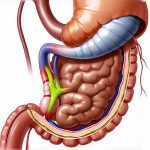Upper abdominal pain is an incredibly common complaint, impacting millions globally. Often dismissed as simply “having a bad stomach,” it can range from mild discomfort after a large meal to intensely debilitating sensations that significantly disrupt daily life. The sheer variety of potential causes makes diagnosing the source of upper abdominal pain challenging, and it’s crucial to understand when seeking professional medical attention is necessary. However, for many individuals experiencing this type of pain, the culprit isn’t a serious illness but rather indigestion, also known as dyspepsia. This article aims to explore the intricacies of indigestion-related upper abdominal pain, covering its causes, symptoms, management strategies, and when it warrants further investigation.
Indigestion isn’t a disease itself; it’s a collection of symptoms indicating that something is disrupting the normal digestive process. It’s frequently triggered by lifestyle factors like overeating, consuming fatty or spicy foods, stress, or even certain medications. Importantly, understanding the specific location and nature of the pain can provide clues as to its likely cause. Pain centered higher in the abdomen might suggest issues with the stomach, while pain slightly lower could indicate problems with the duodenum (the first part of the small intestine). This article focuses specifically on upper abdominal discomfort stemming from functional indigestion – meaning indigestion not linked to an underlying medical condition detectable through standard tests—and aims to empower readers with knowledge to better understand and manage this prevalent issue. Perhaps starting with choosing the right tests can help clarify concerns.
Understanding Indigestion & Its Manifestations
Indigestion encompasses a wide spectrum of uncomfortable sensations, but generally revolves around pain or discomfort in the upper abdomen. This can present differently for various individuals; some describe it as bloating, fullness, nausea, or even burning sensation akin to heartburn. It’s important to differentiate indigestion from heartburn, though they often occur together. Heartburn is specifically a burning feeling rising upwards from the stomach towards the chest, caused by stomach acid refluxing into the esophagus. Indigestion is broader and can include discomfort without noticeable acid reflux. The pain associated with indigestion isn’t usually sharp or stabbing; it’s more commonly described as aching, gnawing, or pressure-like.
The underlying mechanisms of functional indigestion are complex and not fully understood. Current theories suggest that increased sensitivity to normal digestive processes plays a significant role. This means the stomach might be functioning perfectly normally, but the individual perceives it as painful due to heightened nerve sensitivity in the gut. Factors like stress, anxiety, and even past experiences of abdominal discomfort can exacerbate this hypersensitivity. Other potential contributing factors include delayed gastric emptying (food staying in the stomach for longer than normal), or subtle disruptions in gut motility (the movement of food through the digestive tract). It’s possible that underlying anxieties contribute to constipation patterns which can exacerbate discomfort.
While often triggered by dietary choices – large meals, greasy foods, caffeine, alcohol, and carbonated beverages being common culprits – indigestion can also be linked to psychological factors. Stress is a well-known trigger; when stressed, our bodies release hormones that can disrupt digestion and increase gut sensitivity. Similarly, anxiety can lead to increased stomach acid production and altered bowel habits, contributing to digestive discomfort. Identifying personal triggers through careful observation of symptoms in relation to diet and lifestyle choices is the first step toward managing indigestion effectively. For some, this stress may manifest as loose stools.
Lifestyle Modifications & Self-Care Strategies
Managing upper abdominal pain caused by indigestion often begins with simple lifestyle adjustments. These aren’t quick fixes but rather long-term strategies aimed at reducing digestive stress and improving overall gut health. Dietary changes are paramount. – Eating smaller, more frequent meals throughout the day can reduce the workload on the stomach. – Avoiding trigger foods identified through personal observation is essential. – Staying adequately hydrated by drinking plenty of water aids digestion. – Limiting caffeine, alcohol, and carbonated beverages can also minimize symptoms.
Beyond diet, stress management techniques are crucial. Chronic stress significantly impacts digestive function, so incorporating relaxation methods into daily life can be hugely beneficial. This could include practices like deep breathing exercises, meditation, yoga, or simply taking time for activities enjoyed. Regular physical activity is also important; exercise promotes healthy gut motility and reduces stress levels. It’s not about intense workouts but rather consistent movement that feels comfortable and sustainable. Finally, mindful eating – paying attention to the experience of eating, savoring each bite, and avoiding distractions – can significantly improve digestion.
It’s also important to consider meal timing. Eating at least 2-3 hours before lying down allows gravity to assist with digestion and reduces the risk of acid reflux. Avoiding late-night snacking gives the digestive system a chance to rest during sleep. Over-the-counter remedies, such as antacids or simethicone (for bloating), can provide temporary relief but shouldn’t be relied upon long-term without addressing the underlying causes. Consistent reliance on these medications may mask symptoms and delay proper investigation. Sometimes this stems from a fear of losing control over dietary choices.
Identifying & Avoiding Personal Triggers
One of the most effective ways to manage indigestion is to pinpoint individual triggers. This requires a degree of self-awareness and diligent tracking. Keeping a food diary can be incredibly helpful, noting what you eat, when you eat it, and any associated symptoms. Be specific: don’t just write “stomach pain,” but describe the sensation – bloating, burning, aching, etc. – along with its intensity. This diary should also include notes about stress levels, sleep quality, and any medications taken.
After a few weeks of consistent tracking, patterns often emerge. You might notice that spicy foods consistently trigger discomfort or that indigestion is worse after particularly stressful days. Once identified, these triggers can be minimized or avoided altogether. It’s not always necessary to eliminate a triggering food entirely; sometimes, reducing portion sizes or combining it with other foods can make a difference. For example, if dairy causes bloating, trying lactose-free alternatives or consuming smaller amounts of dairy alongside digestive enzymes might alleviate the issue.
Remember that trigger identification is highly individual. What bothers one person won’t necessarily affect another. It’s essential to listen to your body and adjust your diet and lifestyle accordingly. Don’t fall into the trap of restrictive diets based on general advice; focus on what specifically affects you.
The Role of Gut Health & Probiotics
The gut microbiome – the trillions of bacteria residing in our digestive tract – plays a crucial role in overall health, including digestion. An imbalance in this microbial ecosystem, known as dysbiosis, has been linked to various digestive issues, including indigestion. While research is ongoing, there’s growing evidence that supporting a healthy gut microbiome can improve digestive function and reduce symptoms of indigestion.
Probiotics – live microorganisms found in fermented foods like yogurt, kefir, sauerkraut, and kimchi – can help restore balance to the gut microbiome. Probiotic supplements are also available, but it’s important to choose a reputable brand with strains clinically proven to be effective. However, probiotics aren’t a one-size-fits-all solution. Different strains have different effects, so consulting with a healthcare professional or registered dietitian can help determine which probiotic is best suited for your needs.
Beyond probiotics, prebiotics – non-digestible fibers that feed beneficial gut bacteria – are also important. Found in foods like bananas, onions, garlic, and asparagus, prebiotics promote the growth of healthy microbes. A diet rich in fiber generally supports a thriving gut microbiome. Remember to increase fiber intake gradually to avoid bloating or gas.
When To Seek Medical Attention
While most cases of upper abdominal pain caused by indigestion can be managed with lifestyle modifications, it’s vital to recognize when professional medical attention is necessary. If the pain is severe, persistent, or accompanied by other concerning symptoms, seeking medical advice should not be delayed. These warning signs include: – Unintentional weight loss – Difficulty swallowing – Persistent vomiting – Blood in vomit or stool – Anemia (fatigue and weakness) – Fever
These symptoms could indicate a more serious underlying condition, such as peptic ulcer disease, gallbladder problems, pancreatic inflammation, or even gastroesophageal reflux disease (GERD). A healthcare professional can perform diagnostic tests – including endoscopy, blood tests, and imaging scans – to determine the cause of the pain and recommend appropriate treatment. Self-treating for an extended period without improvement also warrants a visit to the doctor. Don’t hesitate to seek medical advice if you are concerned about your symptoms. It’s always better to err on the side of caution when it comes to your health. You might also consider whether a loss of bathroom rhythm is contributing to anxiety and digestive issues.


















